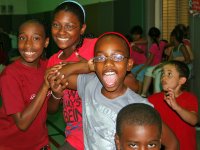Strategies for Multi-Grade-Level PBL Projects
By building in similar learning objectives, starting from different driving questions, and working in flexible learning spaces, PBL projects can foster collaboration between different grade levels.
Your content has been saved!
Go to My Saved Content.When we get really excited by and really effective at implementing project-based learning, we start creating projects that become much more complex. We integrate multiple subjects, leverage more technology tools, co-teach classes, and have projects that last many weeks or even months. These projects are exciting, but a complex project brings more complex challenges. One of those challenges is integration and implementation across different grade levels. Such PBL projects are uniquely complex because schools have different learning outcomes and standards (sometimes drastically different), and also physical structures that create walls against rather than opportunities for collaboration. Here are some strategies and ideas to consider when planning and implementing multi-grade-level PBL projects.
Similar But Different Learning Objectives
Although there will be different learning outcomes because there are different grade levels involved in the project, many learning objectives and standards are similar from one grade level to the next. Learning is always recursive. We learn writing skills one year and get better at them the next year. We learn a science concept in middle school and then learn it again in a more complex way in high school. These are opportunities to integrate across grade levels in a more manageable way. Look for recursive learning outcomes and standards to make manageable assessment choices.
Same Focus, Different Driving Questions
As we know, creating the "just right" driving question can be really challenging, and that challenge becomes greater the more you integrate. With a multi-grade-level project, the complexity of the project may be hard to fit into a single driving question, especially since the learning outcomes are different across the grades. A multi-grade-level project might have a common theme or topic, like water quality or community issues, but the driving questions will vary for different teams or grade levels. In order to focus on specific learning outcomes or standards, be open to similar but different driving questions.
Multi-Grade-Level Collaborative Learning
It can be powerful when students learn together, and we can have students learn from their peers in different grade levels. We all bring our expertise and passions to learning. Younger students can learn from older students and vice versa. Know your students and their strengths and challenges. Form teams or help students form teams based on these strengths and challenges. Don't let age or grade level get in the way. You know your students best, but while considering age difference and the complexities it brings, don't let that hold you back from exploring other possibilities. As students work and learn across grade levels, have them contribute to group products or investigate different foci. Multi-grade-level learning also presents an opportunity for teachers to assess collaboration skills and for students to learn these skills from one another.
Individual Products
In terms of assessment, it's crucial that students are assessed individually. We all want to know what our children know, which may mean an individual product to showcase that learning. Remember, these products can show learning itself or a variety of learning outcomes, some of which may be different than a collaborative product. Teachers and students can decide on the level of voice and choice for these products as well. When implementing a specific multi-grade-level project, an individual product can ensure a laser-like focus on specific grade-level outcomes for an individual student. This also allows students who prefer to work alone the chance to do so. In their case, make sure that they're able to create an individual product.
Flexible Learning Spaces
Instead of a third-grade classroom here and a fifth-grade classroom there, treat classrooms as open spaces where collaboration and purpose, rather than grade level, is the focus. What could each room have that would make it a unique and powerful place to learn, and how will that support elements of the PBL project? Perhaps one classroom would focus on science content and labs, with materials to support the inquiry. Another classroom might be set up with technology tools for learning. Maybe there can be a "feedback" room where students give and receive feedback from others. With flexible learning spaces, teachers become flexible as well, and they help facilitate learning based on the purpose and unique setting of the room. Don't forget hallways and other non-traditional spaces -- they can be ripe places for learning, especially when it comes to PBL projects.
Many of us have already tried these multi-grade-level projects with success. They are rich opportunities to have students learn from other students of different ages, and they present a great opportunity for us, as educators, to learn and grow in our own implementation of PBL.
In the comments section of this post, please share your own thoughts about and experiences with multi-grade-level PBL.
